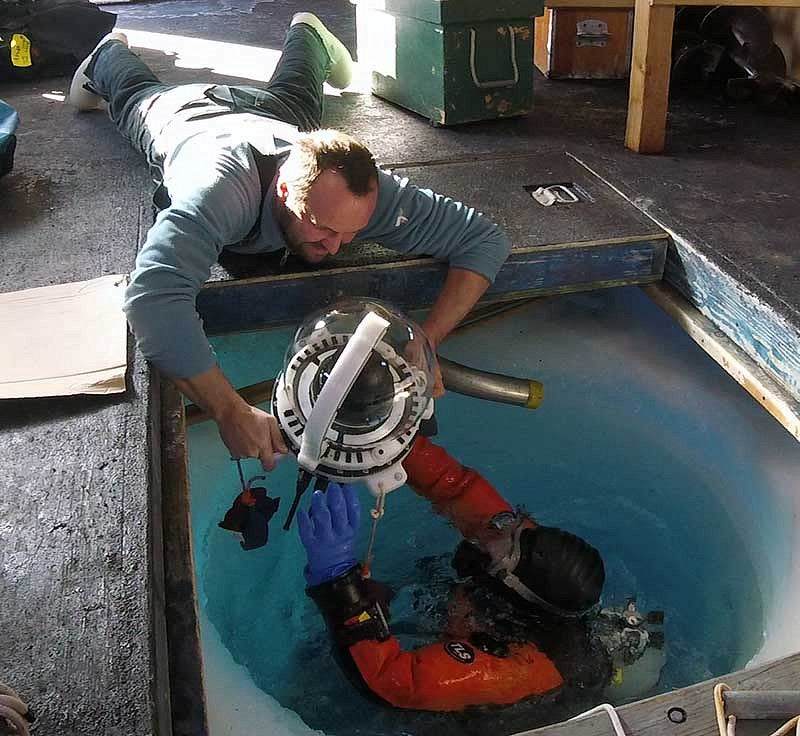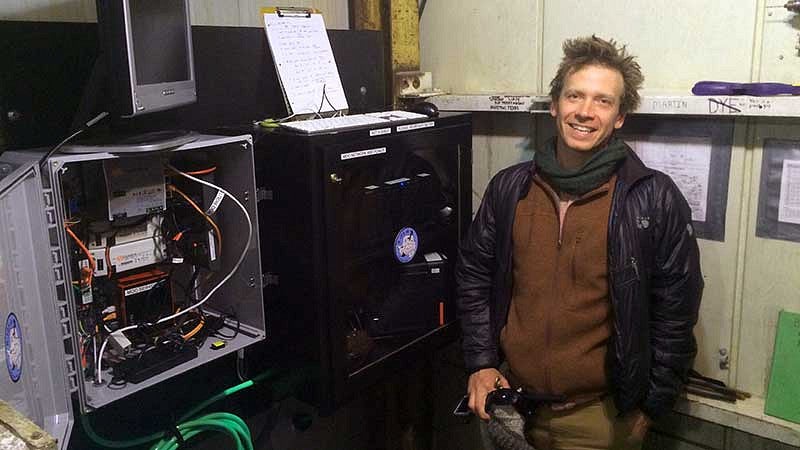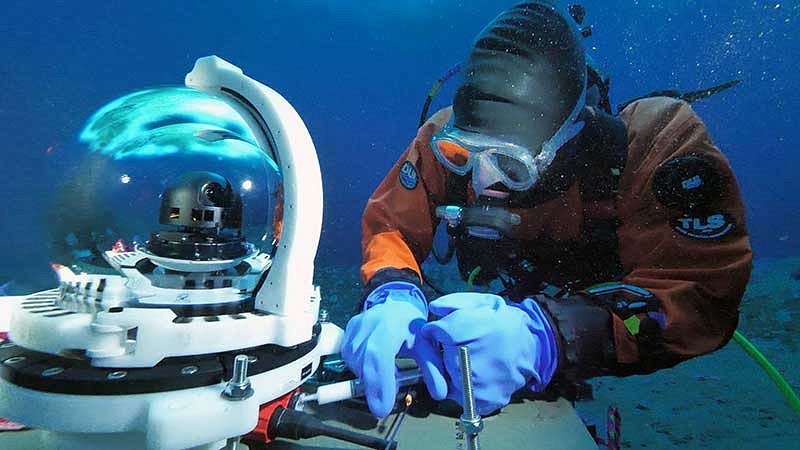Photos by Paul Cziko and Henry Kaiser
With a National Science Foundation grant, University of Oregon biologist Paul Cziko installs a video camera, microphone and ocean sensors 70 feet under the Antarctic sea ice
A new installation pioneered by a University of Oregon biologist is about to open an eye onto the weird and rarely seen realm that lies below the thick, icy crust of Antarctica's Southern Ocean.
The new McMurdo Oceanographic Observatory – the first installation of its kind in Antarctica – also will provide a boost to Antarctic science. A kind of undersea monitoring station, the observatory is the brainchild of UO biologist Paul Cziko.
Late last year, diving in icy, 28-degree-Fahrenheit seawater, 70 feet below an 8-foot-thick layer of solid ice, Cziko led a small team to begin the first stages of opening a window into Antarctica's frozen ocean.
By repeatedly plunging through a 4-foot diameter hole in the ice covering McMurdo Sound, 850 miles from the South Pole, the team installed a suite of live-streaming underwater scientific equipment on the sea floor. The system includes sensors to measure water conditions, an ultra-sensitive microphone and a high-definition video camera.

And now Cziko, a research assistant professor in the UO’s Institute of Ecology and Evolution who has completed seven research seasons in Antarctica, is ready to share his project with the world.
On the observatory’s website, the public will discover live images of an Antarctic underwater seascape and sample the diversity of video, audio and ocean data that the observatory has begun collecting.
"McMurdo Sound is the southernmost accessible marine habitat in the world," Cziko said. "The observatory will help us better understand the unique physical and biological phenomena occurring there year-round. It's an underexplored part of the planet."
Chris Fritsen, director of the National Science Foundation's Antarctic organism and ecosystems program, noted that the new observatory has the potential to meet the two most fundamental goals of any NSF award.
"Through its innovative exploration of McMurdo Sound, the McMurdo Oceanographic Observatory not only has the potential to advance the frontiers of science, it also is an excellent opportunity to help expose a broad cross-section of the public to engaging NSF-funded research in one of Earth's final physical frontiers: the ocean realm," Fritsen said.

As an undergraduate student at the University of Illinois at Urbana-Champaign in 2004, Cziko collected a new species of Antarctic fish just a few feet from where the observatory now stands.
For the initial three years of the project, funded under the National Science Foundation-managed U.S. Antarctic Program, Cziko has teamed up with long-time Antarctic fish researcher Arthur DeVries, an emeritus professor at the University of Illinois. In the 1970's DeVries discovered antifreeze proteins in a group of Antarctic fishes called notothenioids.

The revolutionary finding helped explain how these cold-blooded animals avoid freezing to death in the iciest ocean waters on the planet. These proteins bind to ice crystals and stop them from growing.
"With antifreeze proteins in their blood, notothenioids don't freeze instantly, like your everyday fish would," Cziko said. "But, we've found that environmental ice crystals enter and accumulate inside their bodies, where they may end up blocking blood flow or otherwise harming the fish."
The primary goal of the research is to understand how and when the ice crystals enter the fishes' bodies and what happens to them once they're there.
Cziko originally conceived the McMurdo Oceanographic Observatory as a means to better define the ocean conditions his research subjects were experiencing during field experiments.
"However," he said "we realized that, once we installed a cable through the ice from shore, we could do so much more."

The project establishes continuous data collection for McMurdo Station - the flagship research outpost for U.S. Antarctic Program-supported research. For the first time, station staff can access live temperature, salinity and tide data for the seawater at their doorstep.
Doing so, Cziko said, is important for station operations and useful for other scientists' projects. Personnel on station also can access the underwater video and audio stream live over the station's TV network.
Depending on the time of year, viewers may be treated to a breathtaking scene.
"During the austral spring research season, typically September through November, the view under the ice is spectacular," Cziko said. "The water is crystal clear, and a blanket of shimmering ice crystals covers the sea floor.
In those frigid conditions, the camera is used to watch how the ice grows and how the fishes interact with it. Because of the excellent visibility, that's also the best time to dive and do underwater research.

"It's a very special place to dive," Cziko said. "You can't see the water; you can't feel it. You're neutrally buoyant. It's like you're floating in space, except there's so much life around. It's phenomenal."
Diving under the ice is no easy feat, however. The water is frigid. Divers’ hands often go numb, and they don up to 120 pounds of gear.
“There's is a risk,” he said. “You're always mindful of where the hole is; there's only one way out."
But, by working with rigorously-tested equipment and a safety-oriented mindset, the untethered divers in the U.S. Antarctic Program have an excellent safety record, he said.
By early December, the ice-covered continent slowly begins its march toward summer, and, with it, the water warms a couple of degrees and fills with plankton that reduces visibility to 15 feet.
The warmer season, however, is when the diversity of life in McMurdo Sound blossoms. As waves and wind break open portions of the ice, the resident Weddell seals, with their near-constant eerie and mesmerizing underwater calls, are joined by transitory visitors such as penguins, leopard seals, orca and numerous other whales.
The new technology will help researchers document how the mix of life-form changes over the seasons.

The camera, a high-resolution webcam that points and zooms in all directions, is snuggled inside a protective glass dome, complete with a windshield wiper. The underwater microphone captures the sounds of ice cracking, invertebrate animals grazing on rocks and marine mammal vocalizations at frequencies up to 10 times higher than what humans can hear.
In February, the Antarctic summer began to wane and the sun dipped below the horizon. In another month, Antarctica will settle into complete winter darkness, obscuring the sweeping vista seen from the camera.
Cziko, who controls the observatory from his UO desk 9,000 miles away, will then turn on the lights for short periods each day, so that the camera continues to collect images of a nearby rocky slope. Those images will find their way into time-lapse movies that document seasonal patterns of fish and invertebrate animal behaviors and ice growth.
The observatory now uploads a live image to the internet every few minutes. By September, as the sun again peaks above the horizon and the team prepares for its next Antarctic field season, the hope is to share the live feed with the world for a few hours per week.
The long-term goal is to provide a global audience with everything the observatory sees, hears and measures in real time. But that goal will have to wait for the U.S. Antarctic Program to update its satellite internet capabilities.
"The internet connection from McMurdo Station to the outside world is already completely saturated. It's a tiny and very expensive pipe," Cziko said.
Over time, Cziko said, he aims to keep improving the observatory’s capabilities.
“Right now, our project is really just a proof-of-concept,” he said. “We've shown that we can have a basic ocean-monitoring station under a thick ice cover that is hardwired to shore and that can give us real-time data necessary for our science. And we've also shown that we really can start to share this mysterious, icy ocean world with the public.
“To me,” he added, “that's a very special accomplishment.”
Late last year, diving in icy, 28-degree-Fahrenheit seawater, 70 feet below an 8-foot-thick layer of solid ice, Cziko led a small team to begin the first stages of opening a window into Antarctica's frozen ocean.
By repeatedly plunging through a 4-foot diameter hole in the ice covering McMurdo Sound, 850 miles from the South Pole, the team installed a suite of live-streaming underwater scientific equipment on the sea floor. The system includes sensors to measure water conditions, an ultra-sensitive microphone and a high-definition video camera.

And now Cziko, a research assistant professor in the UO’s Institute of Ecology and Evolution who has completed seven research seasons in Antarctica, is ready to share his project with the world.
On the observatory’s website, the public will discover live images of an Antarctic underwater seascape and sample the diversity of video, audio and ocean data that the observatory has begun collecting.
"McMurdo Sound is the southernmost accessible marine habitat in the world," Cziko said. "The observatory will help us better understand the unique physical and biological phenomena occurring there year-round. It's an underexplored part of the planet."
Chris Fritsen, director of the National Science Foundation's Antarctic organism and ecosystems program, noted that the new observatory has the potential to meet the two most fundamental goals of any NSF award.
"Through its innovative exploration of McMurdo Sound, the McMurdo Oceanographic Observatory not only has the potential to advance the frontiers of science, it also is an excellent opportunity to help expose a broad cross-section of the public to engaging NSF-funded research in one of Earth's final physical frontiers: the ocean realm," Fritsen said.

As an undergraduate student at the University of Illinois at Urbana-Champaign in 2004, Cziko collected a new species of Antarctic fish just a few feet from where the observatory now stands.
For the initial three years of the project, funded under the National Science Foundation-managed U.S. Antarctic Program, Cziko has teamed up with long-time Antarctic fish researcher Arthur DeVries, an emeritus professor at the University of Illinois. In the 1970's DeVries discovered antifreeze proteins in a group of Antarctic fishes called notothenioids.

The revolutionary finding helped explain how these cold-blooded animals avoid freezing to death in the iciest ocean waters on the planet. These proteins bind to ice crystals and stop them from growing.
"With antifreeze proteins in their blood, notothenioids don't freeze instantly, like your everyday fish would," Cziko said. "But, we've found that environmental ice crystals enter and accumulate inside their bodies, where they may end up blocking blood flow or otherwise harming the fish."
The primary goal of the research is to understand how and when the ice crystals enter the fishes' bodies and what happens to them once they're there.
Cziko originally conceived the McMurdo Oceanographic Observatory as a means to better define the ocean conditions his research subjects were experiencing during field experiments.
"However," he said "we realized that, once we installed a cable through the ice from shore, we could do so much more."

The project establishes continuous data collection for McMurdo Station - the flagship research outpost for U.S. Antarctic Program-supported research. For the first time, station staff can access live temperature, salinity and tide data for the seawater at their doorstep.
Doing so, Cziko said, is important for station operations and useful for other scientists' projects. Personnel on station also can access the underwater video and audio stream live over the station's TV network.
Depending on the time of year, viewers may be treated to a breathtaking scene.
"During the austral spring research season, typically September through November, the view under the ice is spectacular," Cziko said. "The water is crystal clear, and a blanket of shimmering ice crystals covers the sea floor.
In those frigid conditions, the camera is used to watch how the ice grows and how the fishes interact with it. Because of the excellent visibility, that's also the best time to dive and do underwater research.

Because of the excellent visibility, that's also the best time to dive and do underwater research. "It's a very special place to dive," Cziko said. "You can't see the water; you can't feel it. You're neutrally buoyant. It's like you're floating in space, except there's so much life around. It's phenomenal."
Diving under the ice is no easy feat, however. The water is frigid. Divers’ hands often go numb, and they don up to 120 pounds of gear.
“There's is a risk,” he said. “You're always mindful of where the hole is; there's only one way out."
But, by working with rigorously-tested equipment and a safety-oriented mindset, the untethered divers in the U.S. Antarctic Program have an excellent safety record, he said.
By early December, the ice-covered continent slowly begins its march toward summer, and, with it, the water warms a couple of degrees and fills with plankton that reduces visibility to 15 feet.
The warmer season, however, is when the diversity of life in McMurdo Sound blossoms. As waves and wind break open portions of the ice, the resident Weddell seals, with their near-constant eerie and mesmerizing underwater calls, are joined by transitory visitors such as penguins, leopard seals, orca and numerous other whales.
The new technology will help researchers document how the mix of life-form changes over the seasons.

The camera, a high-resolution webcam that points and zooms in all directions, is snuggled inside a protective glass dome, complete with a windshield wiper. The underwater microphone captures the sounds of ice cracking, invertebrate animals grazing on rocks and marine mammal vocalizations at frequencies up to 10 times higher than what humans can hear.
In February, the Antarctic summer began to wane and the sun dipped below the horizon. In another month, Antarctica will settle into complete winter darkness, obscuring the sweeping vista seen from the camera.
Cziko, who controls the observatory from his UO desk 9,000 miles away, will then turn on the lights for short periods each day, so that the camera continues to collect images of a nearby rocky slope. Those images will find their way into time-lapse movies that document seasonal patterns of fish and invertebrate animal behaviors and ice growth.
The observatory now uploads a live image to the internet once per minute. By September, as the sun again peaks above the horizon and the team prepares for its next Antarctic field season, the hope is to share the live feed with the world for a few hours per week.
The long-term goal is to provide a global audience with everything the observatory sees, hears and measures in real time. But that goal will have to wait for the U.S. Antarctic Program to update its satellite internet capabilities.
"The internet connection from McMurdo Station to the outside world is already completely saturated. It's a tiny and very expensive pipe," Cziko said.
Over time, Cziko said, he aims to keep improving the observatory’s capabilities.
“Right now, our project is really just a proof-of-concept,” he said. “We've shown that we can have a basic ocean-monitoring station under a thick ice cover that is hardwired to shore and that can give us real-time data necessary for our science. And we've also shown that we really can start to share this mysterious, icy ocean world with the public.
“To me,” he added, “that's a very special accomplishment.”
Additional Videos




